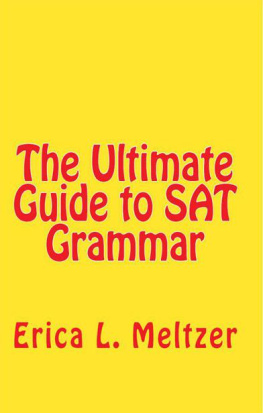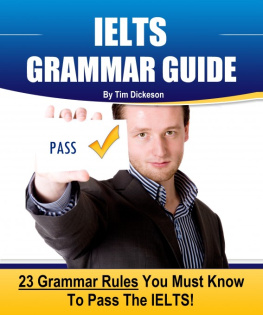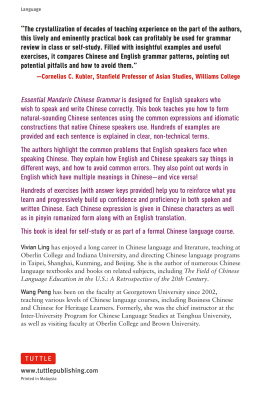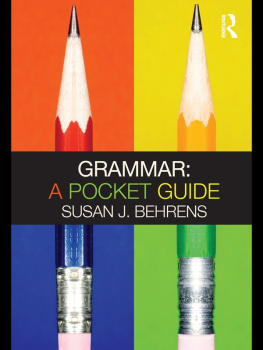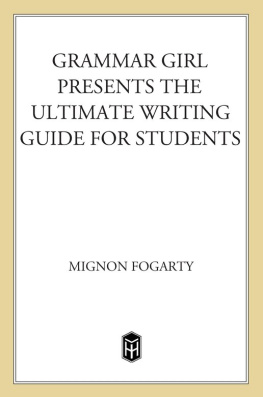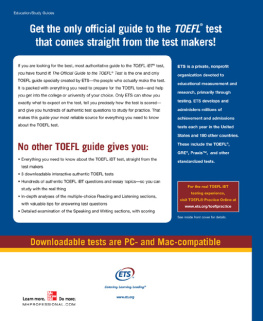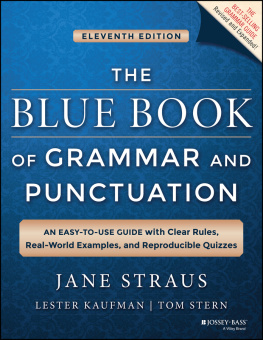
Copyright 2011 Erica Meltzer
All rights reserved.
No part of this publication may be reproduced in any form or by any means, electronic or mechanical, including photocopy, recording, or any information storage and retrieval system, without written permission from the author. For information, please send correspondence to .
ISBN-13: 978-1463599881
ISBN-10: 1463599889
eBook ISBN: 978-1-62112-369-9
To Emma and Joey, for whom these exercises were first written. I know you probably dont want a grammar book dedicated to you, but I hope youll accept the gesture. And to Jane, Joe, Lily, and Frisco, for food, company, inspiration, and hilarity.
CONTENTS
My first encounter with the SAT Writing section came in early 2006, when I answered an online advertisement for practice-SAT test writers. The exam had recently been overhauled to include the Writing section, and suddenly test-prep companies needed lots of new material fast. The first questions I wrote, I regret to say, were not particularly faithful to the actual test. I simply leafed through a College Board guide, generally noted the sorts of questions that appeared, and wrote approximations. No one complained, so I assumed I was doing fine.
As I began spending more time tutoring SAT Writing, however, I began to investigate the section more deeply. Most of my students had little to no familiarity with grammatical terminology, so rather than simply reviewing concepts and offering up a couple of tricks, I had to teach them virtually all of the fundamentals of grammar. And I had to do it fast; there simply wasnt time to teach them four years worth of grammar and then apply it all to the test. Moreover, even if students did have some knowledge of grammar, they simply couldnt figure out what the questions were asking. It seemed that anything could be wrong with those sentences.
So I went back to the College Board book and labeled the kind of error contained in every single multiple-choice grammar question. When I was done, I made a list of all the categories of questions, ranking them in order of frequency. And I began to notice things. I noticed that punctuation problems, for example, occurred only in certain places, as did dangling modifiers and certain kinds of parallelism problems.
More importantly, I noticed that certain key words or phrases included in a sentence often pointed to particular errors.
For example:
-An underlined pronoun often pointed to a pronoun error.
-An underlined verb in the present tense frequently pointed to a subject-verb agreement error.
-The presence of a comparison such as more than/less than at the end of the Error-Identification section almost always pointed to a faulty comparison.
-The mention of a profession physicist, veterinarian, or, in one memorable College Board question, entomologist (someone who studies insects) virtually always indicated a noun agreement question.
And I had a realization: the questions themselves revealed what they were testing.
Furthermore, I noticed that specific kinds of questions always showed up at specific points in the test. For example:
-Faulty comparisons almost always showed up in the last three Error-Identification questions, as did certain kinds of tricky subject-verb agreement questions.
-The final Fixing Sentences question (#11 in the first Writing section, #14 in the second) very frequently dealt with parallel structure.
And so on.
I had cracked the test.
When I started teaching my students to actually anticipate the errors they would find on the test, their scores skyrocketed. The first student I worked with this way raised her SAT Writing score a whopping 180 points to a 750; the next one raised his by 190 points to a 700. Both were admitted to top schools. Although their Writing scores were hardly the deciding factors both were straight-A students it is unlikely that either of their applications would have gotten nearly as close a look with Writing scores in the 500s.
When I was working with both of these students, however, I had a finite number of College Board tests to tutor from. Afraid that I would run out of material, I went to the bookstore and looked through the standard commercially-produced test-prep books for additional exercises. When I looked closely at the practice questions they provided, I realized that not only did they frequently omit a number of major kinds of errors that regularly occurred on the exam, but they also covered rules that were never even tested! Furthermore, the level of the language contained in the sentences was often significantly easier than that found on the actual test. And the correct answer choices often seemed thoroughly arbitrary, a situation that is not true of the SAT. Even if there are trick answers, the right answer is the right answer because it conforms to a particular grammatical rule (not, incidentally, invented by the College Board). So I started writing my own questions. What started as ten or fifteen sentences jotted down on a piece of scrap paper gradually multiplied and multiplied and eventually became this book.
This guide is designed to systematically cover every major concept and type of question that can be reasonably expected to occur on the multiple-choice component of the SAT Writing section. Through a series of cumulative exercises, it also aims to continually reinforce concepts so that material covered early on will not be forgotten. While it contains information that applies to situations well beyond the SAT, its primary focus is that test, and my aim throughout is to make clear the application of particular grammatical rules to the precise ways in which the College Board handles them. I have therefore deliberately simplified explanations of some grammatical principles in order to make certain concepts easier to grasp, and I have also avoided including information that does not directly relate to the exam. The SAT will usually include a few unpredictable questions, but in general, 95% or so of the material tested can be safely anticipated. The goal of this book is to teach you how to anticipate it.
Erica Meltzer
New York City
July 2011
Multiple-Choice Grammar: Overview
The SAT contains 49 multiple-choice grammar and style questions divided between two Writing sections. Those two sections are always arranged as follows:
First Section: 35 questions
-11 Fixing Sentences
-18 Error-Identification
-6 Fixing Paragraphs
Second Section: 14 questions
-14 Fixing Sentences
-Always Section 10
The three kinds of multiple-choice Writing questions are as follows:
1) Fixing Sentences: 25 questions
Test-takers are presented with a sentence, a portion of which is underlined, and are asked to choose the best version.
2) Error-Identification: 18 questions
Test-takers are presented with a sentence that has four underlined words or phrases, along with a No error option (always choice E), and must identify which part, if any, contains an error.
3) Fixing Paragraphs: 6 questions
Test-takers are presented with a short paragraph and are asked questions covering organization, grammar, and logical arrangement of information. Since it is necessary to identify the main idea of the paragraph and decide which evidence best supports it, this section combines both reading and writing skills.
In principle, Error-Identification and Fixing Sentences questions are intended to run from least to most difficult. So, for example, in the first Writing section, #11 is the most difficult Fixing Sentences question, but #12, the first Error-Identification question, starts over at the easiest level. Fixing Paragraphs questions are distributed in no particular order of difficulty.
Next page
